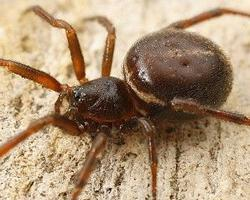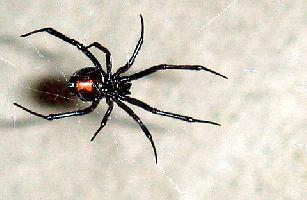
Váhy a míry
| Délka | od 4 do 7 mm |
|---|
Stav ohrožení
| Neohrožen |
Popis zvířete
The Rabbit Hutch Spider, scientifically known as Steatoda bipunctata, is a captivating species of spider that belongs to the family Theridiidae, the same family as the more widely recognized Black Widow spiders. Despite its common name suggesting a preference for rabbit hutches, this spider is versatile in habitat choice, often found in a variety of human-inhabited areas as well as natural settings across Europe and parts of North Africa. It has also been introduced to other parts of the world, including North America and New Zealand, through human activities.Steatoda bipunctata is a small to medium-sized spider, with females typically measuring between 4.5 to 7 millimeters in body length, while males are slightly smaller, ranging from 4 to 6 millimeters. The spider exhibits sexual dimorphism, with females generally larger and more robust than their male counterparts. The coloration of Steatoda bipunctata can vary but often includes a dark brown or black cephalothorax (head and thorax combined) and a similarly dark abdomen. What sets this species apart visually is the distinctive, lighter-colored markings on its abdomen, usually consisting of two or more pale spots or lines, which can sometimes form a crude outline resembling a skull. This characteristic pattern contributes not only to its identification but also to a certain intrigue and aesthetic appreciation.
The Rabbit Hutch Spider, like other members of the genus Steatoda, constructs a tangled, irregular web in which it spends most of its time. These webs are typically built in sheltered, undisturbed locations. In natural environments, they might be found under rocks, in crevices, or among debris. In human-occupied areas, they are often located in sheds, garages, and, as the common name suggests, near or in rabbit hutches, where they can remain relatively hidden and protected from the elements and predators. The web serves as a trap for prey, which mainly consists of insects and other small arthropods. Once a prey item is ensnared in the web, the spider quickly immobilizes it with a bite and then proceeds to consume it at its leisure.
Steatoda bipunctata is known for its venomous bite, which it uses defensively and to subdue prey. However, it is important to note that while its venom can cause discomfort in humans, including pain, swelling, and mild systemic symptoms, it is not considered dangerous. Bites from this species are rare and typically occur only if the spider is provoked or handled carelessly.
Reproduction in Steatoda bipunctata follows a pattern similar to that of many spiders. After a courtship process, which involves careful approaches by the male to avoid being mistaken for prey, the female lays eggs in a silken sac. She may produce several egg sacs over her lifetime, each containing up to several dozen eggs. The female guards these sacs diligently until the spiderlings emerge, demonstrating a level of parental care that ensures the survival of the next generation.
In conclusion, the Rabbit Hutch Spider (Steatoda bipunctata) is a fascinating species that plays a beneficial role in controlling insect populations. Its presence in human environments is often unnoticed due to its reclusive nature and preference for secluded spaces. Despite the unease that spiders can sometimes evoke, Steatoda bipunctata is a relatively harmless neighbor, contributing to the biodiversity and ecological balance of the areas it inhabits.
Podobná zvířata
Nové fotografie zvířat
Top 10 zvířat
- Chinese water dragon (Physignathus cocincinus)
- Galápagos tortoise (Geochelone nigra complex)
- Dolphin gull (Leucophaeus scoresbii)
- Japanese macaque (Macaca fuscata)
- Colombian red howler (Alouatta seniculus)
- Sea urchins (Echinoidea)
- Diana monkey (Cercopithecus diana)
- Moustached guenon (Cercopithecus cephus)
- Common reed warbler (Acrocephalus scirpaceus)
- Common house mosquito (Culex pipiens)
